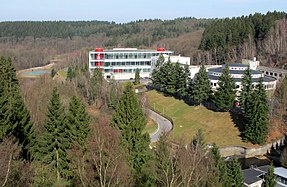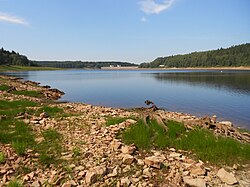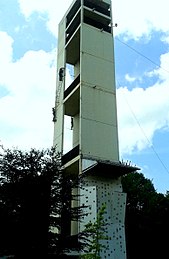Weser dam
| Weser dam | |||||||
|---|---|---|---|---|---|---|---|
| Dam wall | |||||||
|
|||||||
|
|
|||||||
| Coordinates | 50 ° 37 '5 " N , 6 ° 5' 23" E | ||||||
| Data on the structure | |||||||
| Construction time: | 1936-1950 | ||||||
| Height above foundation level : | 66 m | ||||||
| Height of the structure crown: | 362 m | ||||||
| Crown length: | 410 m | ||||||
| Data on the reservoir | |||||||
| Altitude (at congestion destination ) | 358.5 m | ||||||
| Water surface | 1.26 km² | ||||||
| Total storage space : | 25 million m³ | ||||||
| Catchment area | 105.95 km² | ||||||
The Weser dam near Eupen , therefore also known as the Eupener dam , is the most important (drinking) water reservoir in Belgium . It is also a popular destination in the German-Belgian nature reserve of the High Fens . Construction of the dam began in 1936, but political and war-related delays meant that the dam could not be completed and inaugurated until 1950.
history
Already during the period when the region was under French occupation from 1795 to 1815, the first investigations were carried out to build a dam in the upper reaches of the Weser and Hill , which should above all ensure an even water supply for the flourishing local population at the time Cloth industry that had settled along the river in the towns of Eupen , Dolhain , Verviers , Hodimont and Ensival . At that time, the Weser and its tributaries carried enough water with them after every heavy rain and after the snow melted; However, due to the large-scale drainage of the neighboring forests and the introduction of forest cultures, in the intermediate phases some of the streams were dried out and, as a result, the streams were polluted, making them unusable for the cloth industry.
But only years after the region around Eupen had become Prussian in 1815 and the region around Verviers in 1830 Belgian territory, the plan to build a dam was resumed in 1838. Since with the new division of states the upper course of the Weser was now on Prussian territory and the Weser flowed through Belgium below Eupen, there were difficulties with the responsibilities and the possible implementation. It took until 1857 for the city of Verviers to commission engineer Eugène Bidaut (1808–1868) to sound out the construction of a dam in the catchment area of the Gileppe brook. The first results of his investigations showed that the amount of water did not meet expectations; So the city of Verviers contacted Julius The Losen , the President of the Eupen Chamber of Commerce, in order to design a joint dam with him as originally planned, but now across borders. Bidaut incorporated these considerations into his investigations and settled on an area in the area of the tributary of the Getzbach into the Weser. However, since this was only five kilometers above the Eupen district of Haas in the lower town, which with its then around 3,000 inhabitants would have been directly affected if a dam broke, the project met with massive skepticism from the Eupen residents and the Prussian government, which officially started the process in 1864 put to the files.
Nevertheless, in the 1880s, the mayor of Eupen Theodor Mooren, in collaboration with the Aachen dam builder Otto Intze , tried to plan the construction of the Weser dam again; but the Prussian government was still uninterested. It was not until after the First World War that the Eupen district and with it the rivers Weser and Hill had been awarded to the Belgian state that the plans were started again from 1920. With significant support from the mayor of Eupen, Hugo Zimmermann, who has been in office since 1928, and with the appropriate state permits and subsidies, construction could finally begin in 1936 under the direction of chief engineer de Clerk. Since all work was suspended during the Second World War during the occupation of Belgium by the Wehrmacht , the dam could only be completed a few years after the end of the war and inaugurated and put into operation on February 9, 1950 by Auguste Buisseret on behalf of the regent Karl of Belgium, who was prevented by illness be taken. A year later, on June 30, 1951, the new sewage treatment plant at the foot of the Wall was officially opened separately by the Belgian Minister Oscar Behogne .
Before the construction of the dam, the original of the spa fountain male , which was made by the Raeren sculptor Hubert Schiffer and which was originally set up in a grotto in Langesthal next to a spring, was secured by a private person. it has been exhibited in the new Eupen City Museum since 2019 . A replica was set up at the confluence of the Weser and Hill rivers in the Lower Town of Eupen.
investment
The reservoir is fed by two streams: the Belgian Weser (French: Vesdre) and the Getzbach . In addition, the barrier is connected to the Hill via a 1.5 kilometer long connecting tunnel. The dam was built mainly to ensure the drinking water supply of the region, the regulation of the Weser and sufficient quantities of process water for the industry. The dam was built as a gravity dam, made up of concrete blocks that were poured in place. Only the approximately 2000 meter control tunnel inside the wall were made of reinforced concrete. The content of the Weser dam is approx. 25,000,000 m³ and the service water treatment plant at the foot of the dam has a maximum output of around 82,500 m³ per day.
In addition, a small hydropower plant was built with an annual output of 3 to 4 million kilowatt hours. In addition, numerous solar modules were installed on the roofs of the sewage treatment plant, which largely ensures the operation of the plants.
In order to avoid unnecessary pollution of the water from the outset, the entire precipitation area was placed under special protection and, among other things, agricultural use in the catchment area was excluded. In addition, weirs were built at the ends of the arms of the sea to prevent coarse admixtures and to bring about an initial clarification. In addition, with a few exceptions, there is an absolute bathing ban in the entire lake area and the use of motorized sailing or rowing boats, with the exception of the boats of the yacht club.
Water supply to the area
The Weser Reservoir provides 82,500 m³ of treated drinking water every day, which is used to supply the Eupener Land , the Herver Land , the suburbs of Liège and the city of Spa . The treated drinking water is stored in an underground cistern . In conjunction with the Gileppe dam, which is around a hundred years older, the Weser dam supplies around 450,000 water connections. The different amounts of precipitation over the course of the year make it necessary to accumulate the minimum amount that is required for water treatment. During floods, up to 230 m³ of water per second can be drained off in a controlled manner. In order to comply with the EU drinking water regulation that came into force in 2008, a nanofilter system ( membrane technology ) was built at the end of 2009 . This is intended to reduce the content of the carcinogenic trihalomethane , which can arise within the pipeline network when a higher amount of chlorine is added - due to the low water level and high outside temperatures - from 150 to a maximum of 100 mg / m³. The new system also increased the average daily drinking water production from 55,000 to 65,000 m³.
tourism
The dam and the surrounding forests are an attractive local recreation area with numerous attractions for tourists from Eupen and the Aachen area as well as from the nearby Netherlands . The extensive forests of the High Fens with a direct connection to the Eifel on the German side offer numerous opportunities for hiking and cycling tours in the direction of Roetgen , Mützenich , Haus Ternell or the Botrange . At the dam itself, an educational water trail provides information about the history and technical data of the dam, and an educational forest trail provides information about the local flora and fauna. On a plateau above the wall is the "Wesertalsperre visitor center", which consists of a large forest restaurant with outdoor terraces and playgrounds as well as a 33 meter high observation tower. In recent years, this has also been converted into a climbing tower, which is an outdoor facility under the management of the "Sports and Leisure Center Worriken". It can be used by recreational climbers as well as by the Belgian military and in particular for the Royal Military Institute for Physical Education based in Eupen .
literature
- Heinz Godesar: Belgians wanted to help finance the dam , in: Grenz-Echo from July 20, 2019
- Heinz Godesar: Belgians built Gileppe alone , in: Grenz-Echo from August 3, 2019
Web links
- Technical data on structurae.de
- Ceremonial inauguration of the Weser dam , in: Grenz-Echo from February 9, 1950
- Various 360 ° views of the dam and sewage treatment plants
- Portrait on grasehein.de
- Homepage of the visitor center of the Wesertalsperre









